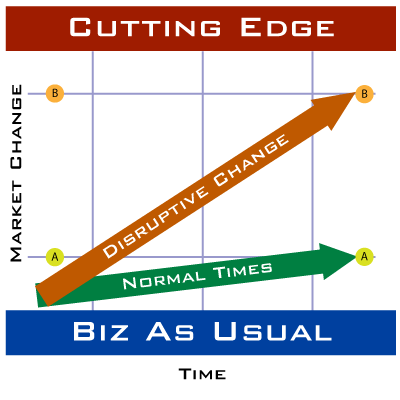In times of disruptive change the cutting edge is the safest place to be.
To many people this seems counterintuitive. If there is rapid change the inclination of most people is to circle the wagons around the familiar. But, when the market is moving, breaking camp and moving forward is actually a lower risk approach. If you are taking risks in your job and trying to invent the future you are actually in a safer position than those who cling to the status quo.
Education Market Forces
The education market is in a period of rapid disruptive change driven by multiple forces.
- Technology is upending traditional textbook markets
- State budgets are under assault from the financial meltdown
- The textbook industry has consolidated into three major players who are using global sourcing to drive down costs for an increasingly commoditized market
- Open source and Web 2.0 technologies are putting the tools of production directly into teacher’s hands
- Content is atomizing and moving to the web
- Teachers are buying everything else on the web – you’re next
Consider the following graphic.

“A” is an incrementalist. In a normal market she will prevail through a steady series of improvements in products and processes. The education publishing world is largely made up of A’s.
“B” is an innovator. In normal times B’s position is really risky but it is the safer place to be during disruption. Generally speaking there are more B’s in Educational Technology.
Whose shoes would you rather be in today? An A trying to hold a position by doing more of what “always worked” or B who is already where the puck is moving?
Like all generalizations this doesn’t do justice to the complexity of the environment but I think it speaks to the major trends we see going on in the market. The old line publishers are struggling to respond to the market changes because the balance of power still tilts to the “A” textbook publishing executives. Their incremental approach isn’t working but they don’t know any other way to tackle the problem.
Sources Of Innovation
Look to the small and mid-size companies – both print and technology based – for the innovations that will drive the future of this market. These companies are being forced to deal with the disruptions more directly since they have a smaller margin for error than the big guys. They are also scrappier in their general approach and more amenable to innovation. I also expect to see change sweep the supplemental market long before it comes to the basal materials market for the same reasons.
Consider the book – not all the innovation we are going to see will be technology based. Books themselves will evolve to reflect the new learning ecosystem. Publishers need to look at every aspect of books and consider what can go in the age of the Kindle, youTube, and Wikipedia. Will the textbook of tomorrow be shorter and have a fully integrated companion site where most of the content is created by students? Its possible. Are you waiting for someone else to try it? Why?
There is innovation going on in the large companies (e.g. Pearson’s forays into blended tech/print products) but most of it is not life or death the way it is in the smaller players.
 Innovation is needed across the entire business model – sales, marketing, editorial, operations, and support are all being affected by the explosion of information in the hands of our customers. This kind of systemic change is really difficult and will take several years to sort itself out.
Innovation is needed across the entire business model – sales, marketing, editorial, operations, and support are all being affected by the explosion of information in the hands of our customers. This kind of systemic change is really difficult and will take several years to sort itself out.
So step out of your comfort zone, try a few things that scare you a bit. The first step is just to become familiar with the new technologies for your own use. Once I got started it was like going back to graduate school – it was a blast to be learning new things every day. You need to re-experience this kind of learning – because it is precisely what we should be providing today’s students in school.
There is a global community waiting for you.
Related Posts
Here are several related posts which expand on concepts in this article.
Textbooks vs. Education Technology – Clash of Paradigms on the different management cultures and how they put the “fun” in disfunction.
Education Publishing – A Wave of Change Sweeps Over the Industry lays out the quantitative case for technology substitution finally happening at scale and what it means for publishers.
10 Ways to Build Instructional Materials for 21st Century Skills presents some ideas on what innovations to focus on if you want to make real change.
 The Education Business Blog
The Education Business Blog

